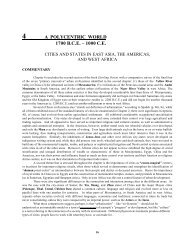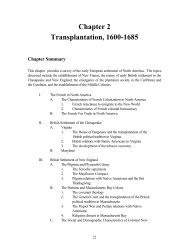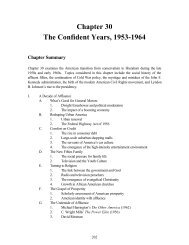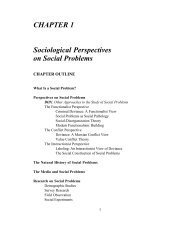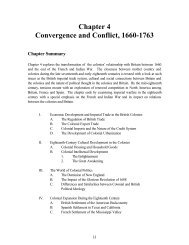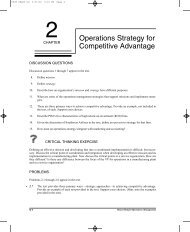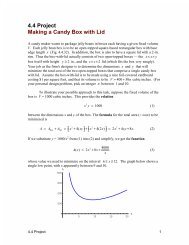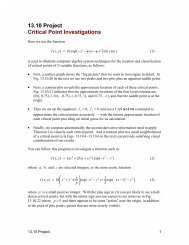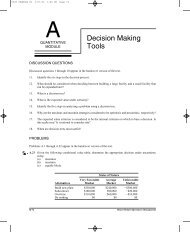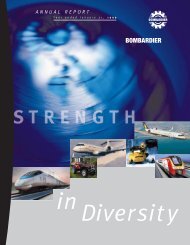Chapter 29 The Cold War at Home and Abroad, 1946-1952
Chapter 29 The Cold War at Home and Abroad, 1946-1952
Chapter 29 The Cold War at Home and Abroad, 1946-1952
You also want an ePaper? Increase the reach of your titles
YUMPU automatically turns print PDFs into web optimized ePapers that Google loves.
<strong>Chapter</strong> <strong>29</strong><br />
<strong>The</strong> <strong>Cold</strong> <strong>War</strong> <strong>at</strong> <strong>Home</strong> <strong>and</strong> <strong>Abroad</strong>,<br />
<strong>1946</strong>-<strong>1952</strong><br />
<strong>Chapter</strong> Summary<br />
<strong>Chapter</strong> <strong>29</strong> examines the post-World <strong>War</strong> II history of America. Topics covered in the chapter<br />
include post-war domestic developments with an emphasis on the conversion to a peacetime<br />
economy <strong>and</strong> the impact of the baby boom; early <strong>Cold</strong> <strong>War</strong> policy including the Marshall Plan<br />
<strong>and</strong> the Truman Doctrine; Truman’s domestic policy focusing on the Fair Deal; <strong>and</strong>, the fruition<br />
of <strong>Cold</strong> <strong>War</strong> politics with the Korean <strong>War</strong> <strong>and</strong> McCarthyism.<br />
I. Launching the Gre<strong>at</strong> Boom<br />
A. Reconversion Chaos<br />
1. <strong>The</strong> return of American GIs<br />
2. Economic shortages <strong>and</strong> infl<strong>at</strong>ion<br />
3. Post-war labor strikes<br />
B. Economic Policy<br />
1. <strong>The</strong> Employment Act of <strong>1946</strong><br />
2. <strong>The</strong> Taft-Hartley Act<br />
C. <strong>The</strong> GI Bill<br />
D. Assembly-Line Neighborhoods<br />
1. <strong>The</strong> post-war housing shortage<br />
2. <strong>The</strong> VA mortgage program<br />
3. Levittown<br />
4. Growth in American home ownership<br />
5. <strong>The</strong> cost of suburbaniz<strong>at</strong>ion<br />
E. Steps toward Civil Rights<br />
1. Changes in federal civil rights policy<br />
2. Racial desegreg<strong>at</strong>ion in professional sports<br />
F. Consumer Boom <strong>and</strong> Baby Boom<br />
1. <strong>The</strong> increase in American marriage r<strong>at</strong>es<br />
2. <strong>The</strong> baby boom <strong>and</strong> increased consumer needs<br />
3. <strong>The</strong> moder<strong>at</strong>ion of American politics<br />
III. Truman, Republicans, <strong>and</strong> the Fair Deal<br />
A. Truman’s Opposition<br />
194
1. Henry Wallace <strong>and</strong> the Progressive party<br />
2. Strom Thurmond <strong>and</strong> the St<strong>at</strong>es’ Rights party (Dixiecr<strong>at</strong>s)<br />
3. Thomas Dewey <strong>and</strong> Republican passivity<br />
B. Whistle-Stopping across America<br />
1. Changes in twentieth-century political style<br />
2. Truman’s whistle-stops<br />
3. <strong>The</strong> results of the 1948 election<br />
C. Truman’s Fair Deal<br />
1. <strong>The</strong> Housing Act of 1949<br />
2. <strong>The</strong> revitaliz<strong>at</strong>ion of Social Security<br />
II. Confronting the Soviet Union<br />
A. <strong>The</strong> End of the Gr<strong>and</strong> Alliance<br />
1. Struggles with the Soviet Union after the war<br />
2. U.S. efforts to organize the post-war world<br />
3. Increasing fear of Soviet aggression<br />
B. <strong>The</strong> Truman Doctrine <strong>and</strong> the Marshall Plan<br />
1. <strong>The</strong> Greek Civil <strong>War</strong> <strong>and</strong> the Truman Doctrine<br />
2. U.S. control of post-war recovery<br />
3. George Kennan <strong>and</strong> the policy of containment<br />
C. Soviet Reactions<br />
1. Soviet pressure in Czechoslavakia<br />
2. <strong>The</strong> Berlin blockade<br />
D. American Rearmament<br />
1. Increased defense budget<br />
2. <strong>The</strong> N<strong>at</strong>ional Security Act of 1947<br />
3. <strong>The</strong> Department of Defense<br />
4. Post-war mutual defense pacts<br />
IV. <strong>Cold</strong> <strong>War</strong> <strong>and</strong> Hot <strong>War</strong><br />
A. <strong>The</strong> Nuclear Shadow<br />
B. <strong>The</strong> <strong>Cold</strong> <strong>War</strong> in Asia<br />
1. <strong>The</strong> defe<strong>at</strong> of Jiang Jieshi<br />
2. “Europe First” or “Asia First”<br />
C. NSC-68 <strong>and</strong> Aggressive Containment<br />
1. A world divided between “slavery” <strong>and</strong> “freedom”<br />
2. <strong>The</strong> promotion of a military solution<br />
3. <strong>The</strong> emergence of an American foreign policy of active intervention<br />
D. <strong>War</strong> in Korea<br />
1. Questions remaining after Mao Zedong’s Chinese takeover<br />
2. <strong>The</strong> st<strong>at</strong>us of Korea after World <strong>War</strong> II<br />
3. Korea as a priority in American defense str<strong>at</strong>egy<br />
4. <strong>The</strong> origins of the Korean <strong>War</strong><br />
195
5. A United N<strong>at</strong>ions police action<br />
E. <strong>The</strong> Politics of <strong>War</strong><br />
1. <strong>The</strong> removal of General Douglas MacArthur<br />
2. <strong>The</strong> impact of the Korean <strong>War</strong><br />
V. <strong>The</strong> Second Red Scare<br />
A. <strong>The</strong> Communist Party <strong>and</strong> the Loyalty Program<br />
1. <strong>The</strong> decline of American communism after World <strong>War</strong> II<br />
2. Republican use of red-baiting against Democr<strong>at</strong>s<br />
3. <strong>The</strong> Truman response to fear of subversion<br />
B. Naming Names to Congress<br />
1. <strong>The</strong> House Committee on Un-American Activities (HUAC)<br />
<strong>and</strong> the Hollywood Ten<br />
2. <strong>The</strong> McCarren Committee<br />
C. Subversion Trials<br />
1. <strong>The</strong> 1949 trials of eleven leaders of the American Communist party<br />
2. <strong>The</strong> Alger Hiss case<br />
3. <strong>The</strong> case of Julius <strong>and</strong> Ethel Rosenberg<br />
D. Sen<strong>at</strong>or McCarthy on Stage<br />
E. Underst<strong>and</strong>ing McCarthyism<br />
1. <strong>The</strong> lasting influence of the Red Scare<br />
2. Factors defining the American fear of Communism<br />
3. <strong>The</strong> goals of McCarthyism<br />
VI. Conclusion<br />
Learning Objectives<br />
After a careful examin<strong>at</strong>ion of <strong>Chapter</strong> <strong>29</strong>, students should be able to:<br />
1. Briefly describe the economic conditions th<strong>at</strong> greeted American GIs on their return<br />
home from war.<br />
2. Explain how post-war labor strikes impacted American sentiment regarding the power<br />
of organized labor.<br />
3. Outline the provisions of the Employment Act of <strong>1946</strong> <strong>and</strong> the Taft-Hartley Act <strong>and</strong><br />
comment on their impacts on the post-war American economy.<br />
4. Identify the provisions of the GI Bill of Rights <strong>and</strong> discuss its impact on American higher<br />
educ<strong>at</strong>ion.<br />
196
5. Comment on how the war’s end impacted the roles of women in the workplace <strong>and</strong> in<br />
higher educ<strong>at</strong>ion.<br />
6. Explain how men such as William Levitt addressed the housing shortage facing<br />
Americans after World <strong>War</strong> II.<br />
7. Comment on the connection between racism <strong>and</strong> suburbaniz<strong>at</strong>ion in post-war America.<br />
8. Briefly outline the steps taken by the Truman administr<strong>at</strong>ion to address civil rights issues<br />
during the l<strong>at</strong>e 1940s.<br />
9. Identify Jackie Robinson <strong>and</strong> explain the significance of his role in desegreg<strong>at</strong>ing<br />
professional sports in the United St<strong>at</strong>es.<br />
10. Comment on the increase in marriage <strong>and</strong> birth r<strong>at</strong>es in post-war America <strong>and</strong> how the<br />
increases impacted n<strong>at</strong>ional consumerism.<br />
11. Discuss how the Truman Doctrine <strong>and</strong> the Marshall Plan reflected the early stages of<br />
American <strong>Cold</strong> <strong>War</strong> policy.<br />
12. List the federal agencies <strong>and</strong> intern<strong>at</strong>ional mutual defense pacts organized by the United<br />
St<strong>at</strong>es during the l<strong>at</strong>e 1940s as a means of increasing n<strong>at</strong>ional security.<br />
13. Identify the major c<strong>and</strong>id<strong>at</strong>es, issues <strong>and</strong> outcome of the presidential election of 1948.<br />
14. List the major components of Truman’s Fair Deal. Indic<strong>at</strong>e the Truman proposals for<br />
domestic reform th<strong>at</strong> were rejected by Congress.<br />
15. Briefly discuss the prolifer<strong>at</strong>ion of nuclear weapons in the world during the 1950s.<br />
Describe the impact of the federal government <strong>and</strong> the media in intensifying public fear of<br />
nuclear war.<br />
16. Briefly describe some of the environmental <strong>and</strong> health problems associ<strong>at</strong>ed with nuclear<br />
testing during the 1950s.<br />
17. Discuss the meaning of the “Europe First” or “Asia First” dilemma facing the west<br />
during the <strong>Cold</strong> <strong>War</strong>.<br />
18. Outline the provisions of NSC-68 <strong>and</strong> explain its impact on the development of<br />
American foreign policy during the 1950s.<br />
19. Identify General Douglas MacArthur <strong>and</strong> describe his role in Japanese post-war<br />
recovery <strong>and</strong> in the Korean <strong>War</strong>.<br />
197
20. Discuss the significance of the Korean <strong>War</strong> in terms of American military effectiveness,<br />
its prediction of future U.S. involvement in Asia <strong>and</strong>, its impact on American commitment to<br />
fighting the <strong>Cold</strong> <strong>War</strong>.<br />
21. Define the term subversives <strong>and</strong> explain its significance to domestic political policy in<br />
the United St<strong>at</strong>es during the 1950s.<br />
22. Define the term red-baiting <strong>and</strong> explain its use by the Republican party during the<br />
1950s.<br />
23. Outline the provisions of Executive Order 9835 <strong>and</strong> describe its impact on the<br />
emergence of the Red Scare.<br />
24. Identify the House Committee on Un-American Activities <strong>and</strong> discuss its role in the Red<br />
Scare. Explain wh<strong>at</strong> is meant by the “Hollywood Ten.”<br />
25. Identify the three major trials of the 1950s which targeted Americans accused of being<br />
Soviet spies.<br />
26. Discuss Sen<strong>at</strong>or Joseph McCarthy’s role in the Red Scare.<br />
27. Identify four factors which explain American fear of subversion during the 1950s.<br />
Identify the goals of the propag<strong>at</strong>ors of the Red Scare.<br />
Topics for Classroom Lecture<br />
1. Present a lecture examining Franklin Roosevelt <strong>and</strong> Harry Truman’s contributions to the<br />
emergence of the <strong>Cold</strong> <strong>War</strong>. Compare <strong>and</strong> contrast the social, political, <strong>and</strong> intellectual<br />
backgrounds of the two men. Discuss with students Roosevelt’s role <strong>at</strong> the Yalta Conference,<br />
especially regarding the endorsement of the Declar<strong>at</strong>ion of a Liber<strong>at</strong>ed Europe. Did the<br />
endorsement of this agreement by the Allies set the stage for <strong>Cold</strong> <strong>War</strong>? Could the Allies have<br />
avoided granting Stalin leverage in eastern Europe? Discuss the extent to which Truman was<br />
prepared by Roosevelt to take over the presidency. Finally, have students comment on the<br />
early Soviet policy of the Truman administr<strong>at</strong>ion.<br />
2. Discuss the emergence of the St<strong>at</strong>es’ Rights party <strong>and</strong> the presidential campaign of J.<br />
Strom Thurmond in 1948. Focus on the party’s appearance as an indic<strong>at</strong>ion of increased racial<br />
tension in the South after World <strong>War</strong> II <strong>and</strong> as an indic<strong>at</strong>ion of the potential for the future Civil<br />
Rights movement. Address the significance of Thurmond’s political career which will involve an<br />
198
early switch to the Republican party, an indic<strong>at</strong>ion of southern political developments to come<br />
during the last half of the twentieth century.<br />
3. Discuss the <strong>Cold</strong> <strong>War</strong> policy’s connection to World <strong>War</strong> II. Wh<strong>at</strong> parallels did the<br />
former Allies see between prewar Germany <strong>and</strong> post-war Soviet Union? Wh<strong>at</strong> mistakes made<br />
prior to World <strong>War</strong> II did the former Allies fear making again? Use this opportunity to have<br />
students consider the issue of “learning from history.” Can we learn from history? Is it wise or<br />
useful to allow mistakes from the past to determine policy for the future?<br />
Topics for Class Discussion <strong>and</strong> Essays<br />
1. In their book, <strong>The</strong> Fifties: <strong>The</strong> Way We Really Were (1975), Douglas T. Miller <strong>and</strong><br />
Marion Nowak assert th<strong>at</strong> the 1950s was a decade of conserv<strong>at</strong>ism, consensus, <strong>and</strong><br />
conformity. Have students review <strong>Chapter</strong> <strong>29</strong> <strong>and</strong> point out examples of these trends during the<br />
l<strong>at</strong>e forties <strong>and</strong> early fifties. How did World <strong>War</strong> II moder<strong>at</strong>e the liberal politics of the<br />
depression era? Why were Americans eager to move to the middle <strong>and</strong> why did they find<br />
security in conserv<strong>at</strong>ism, consensus, <strong>and</strong> conformity?<br />
2. Have students compare <strong>and</strong> contrast the postwar decades of the 1920s <strong>and</strong> the 1950s.<br />
Guide discussion to address some of the following issues:<br />
a. World <strong>War</strong> I has been characterized as the war th<strong>at</strong> ended “American<br />
innocence.” How so? Did the American experience in World <strong>War</strong> II have the same impact?<br />
Were we less naive <strong>and</strong> more experienced <strong>and</strong> m<strong>at</strong>ure as a n<strong>at</strong>ion because of the role we<br />
played in World <strong>War</strong> II?<br />
b. Compare <strong>and</strong> contrast American foreign policy developed during the decades<br />
following the two world wars. Specifically focus on the issues of isol<strong>at</strong>ionism <strong>and</strong> active<br />
intervention as they apply to American foreign policy of the twenties <strong>and</strong> the fifties.<br />
c. Examine the social <strong>and</strong> cultural aspects of postwar American society in the<br />
twenties <strong>and</strong> the fifties. How do the social <strong>and</strong> cultural values of Americans reflect their reaction<br />
to world war?<br />
d. Explore developments in domestic politics. Which party will domin<strong>at</strong>e n<strong>at</strong>ional<br />
politics after World <strong>War</strong> I? After World <strong>War</strong> II? Wh<strong>at</strong> will be the American response to<br />
radicalism after World <strong>War</strong> I? After World <strong>War</strong> II?<br />
3. Consider American <strong>Cold</strong> <strong>War</strong> foreign policy within the historical context of modern<br />
American foreign policy. Students have already considered the similarities <strong>and</strong> differences<br />
between the turn of the century diplomacy of <strong>The</strong>odore Roosevelt <strong>and</strong> the moral diplomacy of<br />
Woodrow Wilson. How does <strong>Cold</strong> <strong>War</strong> policy compare to each of these phases of American<br />
foreign policy development? Consider specifically the content of NSC-68. Are the guidelines<br />
proposed in this document reflective of the “big stick” diplomacy of <strong>The</strong>odore Roosevelt or are<br />
199
they more reflective of the morally based approach of Woodrow Wilson? Or is post-World<br />
<strong>War</strong> II foreign policy completely different from both?<br />
Topics for Class Projects <strong>and</strong> Term Papers<br />
1. Research the American experience in fighting war in Asia during the last half of the<br />
twentieth century. This project could focus on the Pacific <strong>War</strong> during World <strong>War</strong> II, the<br />
Korean <strong>War</strong>, <strong>and</strong> the Vietnam <strong>War</strong>. Among the topics th<strong>at</strong> students might examine, consider:<br />
a. <strong>The</strong> cultural differences between the East <strong>and</strong> the West. Wh<strong>at</strong> barriers existed<br />
th<strong>at</strong> would complic<strong>at</strong>e Asian <strong>and</strong> American underst<strong>and</strong>ing of each other’s cultures? How would<br />
these misunderst<strong>and</strong>ings complic<strong>at</strong>e diplomacy?<br />
b. <strong>The</strong> political <strong>and</strong> military goals of Asians <strong>and</strong> Americans in war. Especially in<br />
Korea <strong>and</strong> Vietnam, how did American global concerns compliment or fail to compliment the<br />
regional concerns of Koreans <strong>and</strong> the Vietnamese? How did regional civil wars turn into<br />
military manifest<strong>at</strong>ions of <strong>Cold</strong> <strong>War</strong>?<br />
c. Racism <strong>and</strong> the American experience in Asia. Have students consider<br />
American stereotypes regarding Asians. How were these stereotypes manifested during the<br />
Pacific <strong>War</strong>? During the Korean <strong>War</strong>? During the Vietnam <strong>War</strong>? Were Americans socially<br />
<strong>and</strong> culturally prepared to fight for the well being of the Asian world?<br />
2. Research the emergence of the Progressive party in 1948. Was Henry Wallace’s<br />
liberal agenda in 1948 d<strong>at</strong>ed <strong>and</strong> archaic by the end of the World <strong>War</strong> II or did it predict <strong>and</strong><br />
foresee the domestic reform agenda of the l<strong>at</strong>e 1950s <strong>and</strong> 1960s? Examine the role of the party<br />
as a link between the progressive agenda of the depression era <strong>and</strong> the progressive agenda of<br />
the 1960s.<br />
Resources for Lectures <strong>and</strong> Research Projects<br />
Gal Alperovitz, Atomic Diplomacy, (1994).<br />
Frances Fitzgerald, Fire on the Lake (1972).<br />
John L. Gaddis, <strong>The</strong> United St<strong>at</strong>es <strong>and</strong> the Origins of the <strong>Cold</strong> <strong>War</strong>, 1941-1947, (1972).<br />
Joseph C. Goulden, <strong>The</strong> Best Years, 1945-1950 (1976).<br />
Alonzo Hamby, Beyond the New Deal: Harry S. Truman <strong>and</strong> American Liberalism (1973).<br />
Akira Iriye, <strong>The</strong> <strong>Cold</strong> <strong>War</strong> in Asia (1974).<br />
Elaine Tyler May, <strong>Home</strong>ward Bound: American Families in the <strong>Cold</strong> <strong>War</strong> Era (1988).<br />
Miller <strong>and</strong> Nowak, <strong>The</strong> Fifties: <strong>The</strong> Way We Really Were (1977).<br />
200
John Tol<strong>and</strong>, <strong>The</strong> Rising Sun, 1970).<br />
Stephen J. Whitfield, <strong>The</strong> Culture of <strong>Cold</strong> <strong>War</strong>, (1990).<br />
Audio-Visual Resources<br />
<strong>The</strong> Twentieth Century with Mike Wallace: McCarthy Reconsidered, <strong>The</strong> History<br />
Channel, 50 minutes.<br />
Mike Wallace takes a fresh look <strong>at</strong> the man behind the Second Red Scare.<br />
Truman: <strong>The</strong> American Experience, David Grubin, 1997, 270 minutes.<br />
This video is a 4-part series examining the life <strong>and</strong> presidency of Harry Truman.<br />
201



